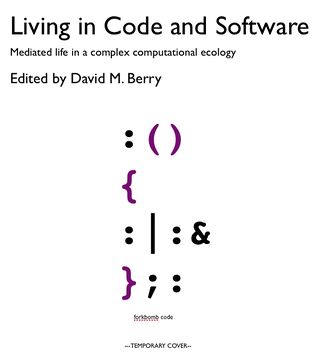Life in Code and Software/: Difference between revisions
Davidberry (talk | contribs) |
Davidberry (talk | contribs) |
||
| Line 41: | Line 41: | ||
Matrosov, A., Rodionov, E., Harley, D. and Malcho, J. (n.d.) Stuxnet Under the Microscope, accessed 04/03/2012, | Matrosov, A., Rodionov, E., Harley, D. and Malcho, J. (n.d.) Stuxnet Under the Microscope, accessed 04/03/2012, | ||
http://go.eset.com/us/resources/white-papers/Stuxnet_Under_the_Microscope.pdf | http://go.eset.com/us/resources/white-papers/Stuxnet_Under_the_Microscope.pdf | ||
<br> | <br><br> | ||
[http://vimeo.com/9790850 Algorithms are Thoughts, Chainsaws are Tools by Stephen Ramsay] | [http://vimeo.com/9790850 Algorithms are Thoughts, Chainsaws are Tools by Stephen Ramsay] | ||
Revision as of 22:39, 15 March 2012

Mediated life in a complex computational ecology
ISBN: 978-1-60785-XXX-X
edited by David Berry
Introduction: What is code and software?
This book explores the relationship between living and code and software. It does so because these technologies are increasingly part of our urban environment, and indeed stretching even to very remote areas of the world. The book introduces and explores the way in which code and software become the conditions of possibility for human living, crucially becoming a computational ecology which we inhabit. As such we need to take account of this new computational world and think about how we live today in a highly mediated code-based world.(more...)
Thinking Software
What is a Turing Machine? by Wolfram Alpha
Kevin Slavin: How algorithms shape our world
Kevin Slavin argues that we're living in a world designed for -- and increasingly controlled by -- algorithms. He shows how these complex computer programs determine: espionage tactics, stock prices, movie scripts, and architecture. And he warns that we are writing code we can't understand, with implications we can't control.
Code Literacy ('iteracy')
Show Us Your Screens by Louis McCallum and Davy Smith
A short documentary about live coding practise by Louis McCallum and Davy Smith.
Decoding Code
Ralph Langner: Cracking Stuxnet, a 21st-century cyber weapon
When first discovered in 2010, the Stuxnet computer worm posed a very strange puzzle. Beyond its unusually high level of sophistication loomed a more troubling mystery: what was its purpose? Ralph Langner and team helped crack the programming code that revealed this digital warhead's final target – and its origins in international politics and cyberwarfare. This is a fascinating look inside cyber-forensics and the processes of reading code to understand how it works and what it attacks.
Matrosov, A., Rodionov, E., Harley, D. and Malcho, J. (n.d.) Stuxnet Under the Microscope, accessed 04/03/2012,
http://go.eset.com/us/resources/white-papers/Stuxnet_Under_the_Microscope.pdf
Algorithms are Thoughts, Chainsaws are Tools by Stephen Ramsay
A short film on livecoding presented as part of the Critical Code Studies Working Group, March 2010, by Stephen Ramsay. Presents a "live reading" of a performance by composer Andrew Sorensen.
Wendy Chun - Critical Code Studies
Wendy Chun giving a lecture on code studies and reading source code.
Federica Frabetti - Critical Code Studies
Federica Frabetti giving a lecture on code studies and reading source code.
Software Ecologies
Kitchin, R. (2012) The Programmable City, Environment and Planning B: Planning and Design, volume 38, pages 945-951, accessed 15/03/2012, http://www.envplan.com/epb/editorials/b3806com.pdf
